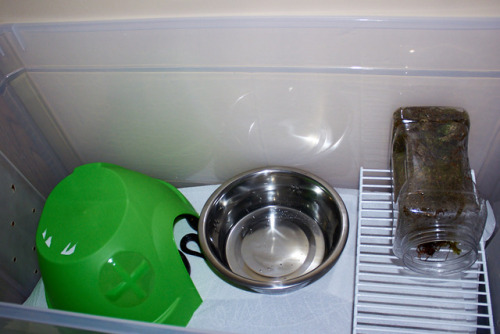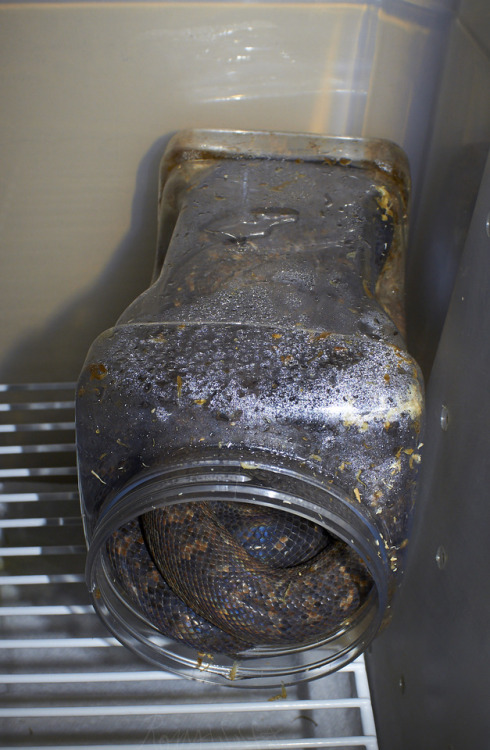#chilabothrus striatus
Ivo: Is not going to hesitate to take the food. Use 24″ hemostats in case she misses. (She has missed before and bitten the tongs, realized that’s not the rat, and gone back of her own accord to find the rat. Be safe!)
Newdle (Working Title): Is cautiously investigative of the food. Hisses a lot at all things. Once he realizes that food is present, he will gently take the food from the tongs.
Matilda: I used to have to set her food in her enclosure and wait for her to find it, but now she’ll feed from tongs! She’s a very dependable eater.
Shoelace™: Has already become aware that there is food in the area, and is standing at the top of the enclosure waiting for you to open the door and give her the food. INCREDIBLY FOOD MOTIVATED. Not too strikey though, thankfully. Holds her food and waits until you’re done feeding the other snakes before actually eating it, so I often feed her last. When she’s done eating, she cruises around looking for more food no matter HOW big her meal was… please calm down???
Neku: Generally a reliable feeder. Usually drags the food back into his favorite tube to eat in solitude. (Solitube…)
Joshua: Is scared of all food over a certain size………. can be a problem feeder. Often mock-strikes to try and make the food go away. Once he actually bites it and realizes that it is, in fact, food, you’re usually good to go…
Lucy: Is there, waiting for the food from out of a hide, blep blep i’m heckin hunger. Has an insane strike when she takes her food, often prompts calls of “that’s my girl!”
Worm: Does not feed from tongs. I have to lay her food under a hide and wait for her to find them. I put the food in the same place every time, so she usually does! She’s going to go off food soon, she doesn’t eat during the winter.
Orange Juice: …I often have to unbury her head and tap her with the food for her to know it’s there… she usually finds it on her own when I leave it in there, but other times she just misses a week of food, and I hate that, so I just… present her with the food. She’s doing her best…
I’ve not posted one of my quarantine bins before I don’t think! This is where the Newdle currently lives – it’s austere, but it serves his needs while allowing me to monitor his health. As far as quarantine goes, my goals are to suit the inhabitant first, and to do it in such a way that can be sterilized clean and easily monitored for things like mites second. If you’re crafty, you can do both without compromising either goal. Prettiness can come later – quarantine’s a time for pure function!
This is a long ramble, so I’m putting this under a read-more!
To start this off, since I know a lot of people dislike bins, I’ll go into why I personally am using one in this specific scenario. For most snakes (as I can only speak from a snake perspective here,) I generally prefer them to the big glass enclosures you see at most pet stores; nice as they are, they’re expensive, fragile, and have to be modified to hold humidity and heat – and because of their weight and the aforementioned fragility, cleaning them is like punching yourself in the face. Mites can hide in the crevices of the glass that are incredibly hard to get into, as well, which is far from ideal for quarantine in my opinion! While they have their uses, and I do own a fair few of them, overall I’m gonna go for a bin in most cases for my snakes – but especially if humidity is a concern, as bins hold humidity overwhelmingly better than unmodified glass aquariums. (It’s also worth mentioning that there are also custom-made enclosures that are the best of both worlds, and generally those are the best option to go with overall – but the cost can be prohibitive, especially if you gotta ship freight.)
That was The Bin Manifesto. Now to the actual enclosure!
First things first, he’s being housed on kitchen roll. Mites show up great on white paper, and it’s a cheap and easily replaced medium for lining the bottom of the bin. (It’s not great for humidity purposes, however, so I mist as needed to make sure it doesn’t dry out too much.) Cleaning is a breeze, just replace it all, clean out the bin, put it all together again, and you’re golden! After quarantine, I’ll move this fellow onto a humidity-friendly substrate, probably orchid bark with pillow moss.
(Unseen but important! Underneath the kitchen roll is a temperature probe that regulates how hot the undertank heater is allowed to get! This makes sure that the heater I’m using is safe for my friend here! Never skimp on the thermostat/rheostat folks!)
Next, the green hide is on the warm side. The hide itself is uhh, this plastic bit made for guinea pigs and other large rodents… it’s huge and cheap and I LOVE THEM because I can spray them down no matter WHAT happens to them. Ivo has one too! She wedges herself up in there and feels nice and tight and secure. They’re only like 9 dollars, and I literally have not found anything better not named “PVC pipe” for large snake hides. It’s not the most decorative, but it does the job fantastically.
Further on, there’s a shelf for climbing since this is a semi-arboreal species. It’s sturdy and very cheap and you can get them in the Big Lots for about 3 dollars, and I use them for anything that likes to climb in quarantine because they can be sprayed down and sterilized – which, again, is the goal here. Sanitation! They’re not the comfiest thing, admittedly, but they’ll do the job until I clear this fellow for some of my driftwood.
(Speaking of: enclosure wood is expensive. Terribly so. But it’s because it takes such a ton of work to prepare the wood – me sitting on my back porch at the picnic table with a power sander, a saw, and a lot of profanity for several hours = one (1) appropriate piece of wood for an enclosure. It’s worth the money for someone else to save you the labor if you can afford it, trust me. I would kill a man for a sandblaster.)
On top of that shelf, we have the second hide. It’s a moist hide full of damp sphagnum moss that he likes to wedge himself into. Moist hides help raise the ambient humidity in an enclosure, and he can curl up in there whenever he likes – but I also mist a time or two to help keep the humidity up, if I need to.The way I drilled the holes into the bin ensures that humidity doesn’t escape too fast (and that the air won’t stagnate, either,) so I usually don’t have to mist too often!
But… yes, that’s a bit on the setup that the Newdle’s currently living in. It’s clean, efficient, adequate, and roomy – and for this fellow, it’s a good fit. At the end of the day the best enclosure is the one that meets in the center of the Venn Diagram between cleanliness and husbandry, and that can vary wildly from animal to animal – so I don’t endorse this as a one-size-fits-all solution, it’s simply how I’m doing things over here!
Thank you for reading!
Post link
This is the Newdle (working title) and he likes to wedge himself into containers. He’s a Dominican Red Mountain Boa, and I’ll do a writeup of what that means…eventually. He’s got a huge personality and I love him with my whole heart. friend!!!!
Post link


